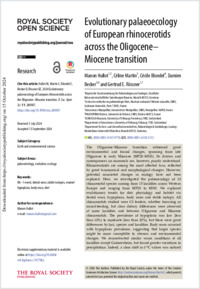Evolutionary palaeoecology of European rhinocerotids across the Oligocene–Miocene transition
DOKPE
- Hullot, Manon ORCID Sorbonne Université, Paris, France
- Martin, Céline Université de Montpellier, France
- Blondel, Cécile Université de Poitiers, France
- Becker, Damien University of Fribourg
- Rössner, Gertrud E. ORCID Ludwig-Maximilians-Universität München, Germany
- 2024
Published in:
- Royal Society Open Science. - London, UK: The Royal Society. - 2024, vol. 11, no. 10
English
The Oligocene–Miocene transition witnessed great environmental and faunal changes, spanning from late Oligocene to early Miocene (MP28–MN3). Its drivers and consequences on mammals are, however, poorly understood. Rhinocerotoids are among the most affected taxa, reflected by great taxonomical and morphological changes. However, potential associated changes in ecology have not been explored. Here, we investigated the palaeoecology of 10 rhinocerotid species coming from 15 localities across Western Europe and ranging from MP28 to MN3. We explored evolutionary trends for diet, physiology and habitat via dental wear, hypoplasia, body mass and stable isotopy. All rhinocerotids studied were C3 feeders, whether browsing or mixed-feeding, but clear dietary differences were observed at some localities and between Oligocene and Miocene rhinocerotids. The prevalence of hypoplasia was low (less than 10%) to moderate (less than 20%), but there were great differences by loci, species and localities. Body mass covaried with hypoplasia prevalence, suggesting that larger species might be more susceptible to stresses and environmental changes. We reconstructed similar warm conditions at all localities except Gaimersheim, but found greater variations in precipitation. Indeed, a clear shift in δ13C values was noticed at the end of the Oligocene, consistent with climatic and vegetation changes reported at that time.
- Faculty
- Faculté des sciences et de médecine
- Department
- Département de Géosciences
- Language
-
- English
- Classification
- Palaeontology
- License
- CC BY
- Open access status
- gold
- Identifiers
-
- DOI 10.1098/rsos.240987
- ISSN 2054-5703
- Persistent URL
- https://folia.unifr.ch/unifr/documents/329760
Statistics
Document views: 31
File downloads:
- hullot-et-al-2024-evolutionary-palaeoecology-of-european-rhinocerotids-across-the-oligocene-miocene-transition.pdf: 113
